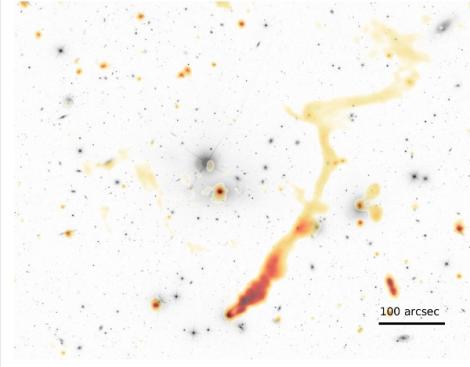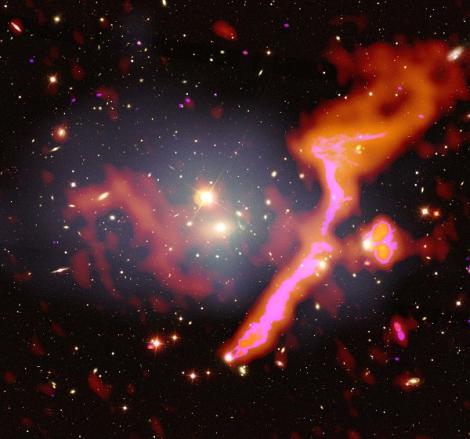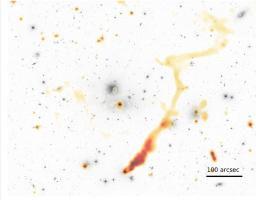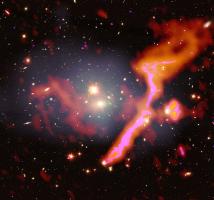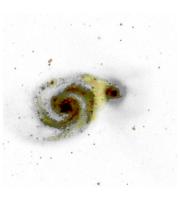An international team of more than 200 astronomers from 18 countries has published the first phase of a major new radio sky survey at unprecedented sensitivity using the Low Frequency Array (LOFAR) telescope. The survey reveals hundreds of thousands of previously undetected galaxies, shedding new light on many research areas including the physics of black holes and how clusters of galaxies evolve. A special issue of the scientific journal Astronomy & Astrophysics is dedicated to the first twenty-six research papers describing the survey and its first results.
Radio astronomy reveals processes in the Universe that we cannot see with optical instruments. In this first part of the sky survey, LOFAR observed a quarter of the northern hemisphere at low radio frequencies. At this point, approximately ten percent of that data is now made public. It maps three hundred thousand sources, almost all of which are galaxies in the distant Universe; their radio signals have travelled billions of light years before reaching Earth.
Black holes
Huub Röttgering, Leiden University (The Netherlands): “If we take a radio telescope and we look up at the sky, we see mainly emission from the immediate environment of massive black holes. With LOFAR we hope to answer the fascinating question: where do those black holes come from?” What we do know is that black holes are pretty messy eaters. When gas falls onto them they emit jets of material that can be seen at radio wavelengths.
Philip Best, University of Edinburgh (UK), adds: “LOFAR has a remarkable sensitivity and that allows us to see that these jets are present in all of the most massive galaxies, which means that their black holes never stop eating.”
Clusters of galaxies
Clusters of galaxies are ensembles of hundreds to thousands of galaxies and it has been known for decades that when two clusters of galaxies merge, they can produce radio emission spanning millions of light years. This emission is thought to come from particles that are accelerated during the merger process. Amanda Wilber, University of Hamburg (Germany), elaborates: “With radio observations we can detect radiation from the tenuous medium that exists between galaxies. This radiation is generated by energetic shocks and turbulence. LOFAR allows us to detect many more of these sources and understand what is powering them."
Annalisa Bonafede, University of Bologna and INAF (Italy), adds: “What we are beginning to see with LOFAR is that, in some cases, clusters of galaxies that are not merging can also show this emission, albeit at a very low level that was previously undetectable. This discovery tells us that, besides merger events, there are other phenomena that can trigger particle acceleration over huge scales.”
Magnetic fields
“Magnetic fields pervade the cosmos, and we want to understand how this happened. Measuring magnetic fields in intergalactic space can be difficult, because they are very weak. However, the unprecedented accuracy of the LOFAR measurements has allowed us to measure the effect of cosmic magnetic fields on radio waves from a giant radio galaxy that is 11 million light years in size. This work shows how we can use LOFAR to help us understand the origin of cosmic magnetic fields", explains Shane O'Sullivan, University of Hamburg.
High-quality images
Creating low-frequency radio sky maps takes both significant telescope and computational time and requires large teams to analyse the data. “LOFAR produces enormous amounts of data - we have to process the equivalent of ten million DVDs of data. The LOFAR surveys were recently made possible by a mathematical breakthrough in the way we understand interferometry”, says Cyril Tasse, Observatoire de Paris - Station de radioastronomie à Nançay (France).
“We have been working together with SURF in the Netherlands to efficiently transform the massive amounts of data into high-quality images. These images are now public and will allow astronomers to study the evolution of galaxies in unprecedented detail”, says Timothy Shimwell, Netherlands Institute for Radio Astronomy (ASTRON) and Leiden University.
SURF's compute and data centre located at SURFsara in Amsterdam runs on 100 percent renewable energy and hosts over 20 petabytes of LOFAR data. “This is more than half of all data collected by the LOFAR telescope to date. It is the largest astronomical data collection in the world. Processing the enormous data sets is a huge challenge for scientists. What normally would have taken centuries on a regular computer was processed in less than one year using the high throughput compute cluster (Grid) and expertise”, says Raymond Oonk (SURFsara).
LOFAR
The LOFAR telescope, the Low Frequency Array, is unique in its capabilities to map the sky in fine detail at metre wavelengths. LOFAR is operated by ASTRON in The Netherlands and is considered to be the world’s leading telescope of its type. “This sky map will be a wonderful scientific legacy for the future. It is a testimony to the designers of LOFAR that this telescope performs so well”, says Carole Jackson, Director General of ASTRON.
Contribution from Polish universities
Two Polish universities were involved in the new survey: Jagiellonian University in Kraków (JU), and Nicolaus Copernicus University in Toruń (NCU). Contribution from Kraków' scientists is described by Krzysztof Chyży from JU: “Our team consisted of six people. We took part in identification and classification of thousands of radio sources from the new survey. We were also looking for the origin of the dependence of radio emission on the star-forming activity in spiral galaxies, analysed how are the cosmic ray particles escaping from their host galaxies, and searched for cosmic magnetic fields. In addition, one of the now published articles – discussing if the extended radio emission in galaxy groups is a common phenomenon, an issue yet scarely studied – was an original idea of one of the scientists from the Astronomical Observatory”. “Scientists from Toruń also took an active participation in preparation of this enormous catalogue of radio sources. In addition, we analysed the origin of radio emission in extremely rare quasars characterised by highly powerful matter outflows from accretion disks that surround their central, supermassive black holes (Broad Absorption Line Quasars, BAL)” – says Magdalena Kunert-Bajraszewska from NCU.
Poland has been a full member of the ILT since 2015, and operates now three LOFAR stations: in Bałdy (governed by the University of Warmia and Mazury), in Borówiec (run by the Space Research Centre of the Polish Academy of Sciences ), and in Łazy (belonging to the Jagiellonian University). Participation of Polish scientists was made possible thanks to the funding from the Ministry of Science and Higher Education, and the National Centre for Science.
The next step
The 26 research papers in the special issue of Astronomy & Astrophysics were done with only the first two percent of the sky survey. The team aims to make sensitive high-resolution images of the whole northern sky, which will reveal 15 million radio sources in total. “Just imagine some of the discoveries we may make along the way. I certainly look forward to it”, says Jackson. “And among these there will be the first massive black holes that formed when the Universe was only a ‘baby’, with an age a few percent of its present age”, adds Röttgering.
More information
Institutes publishing the results

LOFAR
The international LOFAR telescope (ILT) consists of a European network of radio antennas, connected by a high-speed fibre optic network spanning seven countries. LOFAR was designed, built and is now operated by ASTRON (Netherlands Institute for Radio Astronomy), with its core located in Exloo in the Netherlands. LOFAR works by combining the signals from more than 100,000 individual antenna dipoles, using powerful computers to process the radio signals as if it formed a ‘dish’ of 1900 kilometres diameter. LOFAR is unparalleled given its sensitivity and ability to image at high resolution (i.e. its ability to make highly detailed images), such that the LOFAR data archive is the largest astronomical data collection in the world and is hosted at SURFsara (The Netherlands), Forschungszentrum Juelich (Germany) and the Poznan Super Computing Center (Poland). LOFAR is a pathfinder of the Square Kilometre Array (SKA), which will be the largest and most sensitive radio telescope in the world.
Images and video
Images and audiovisual material can be downloaded at:
https://www.dropbox.com/sh/hfcfb9a6sblho8m/AAA7s1lnMsB5Z3x71qX9CptMa?dl=0
More images are available on https://www.lofar-surveys.org/gallery_preview.html
The 5-minute version of the promotional movie with Polish subtitles can be found on the YouTube: https://www.youtube.com/watch?v=GJ1YK5sKdTw&feature=youtu.be
All the research papers in the special issue of Astronomy & Astrophysics can be found at: https://www.aanda.org/component/toc/?task=topic&id=920
Rafaël Mostert (Leiden University) has made a website where you can explore the most common shapes of the 320,000 radio objects that the LOFAR Survey has detected so far: http://rafaelmostert.com/lofar/som.php. See the difference between radio, optical and infrared versions of these objects. On the page http://rafaelmostert.com/lofar/outliers.php you can see the most uniquely shaped radio-objects within the survey, some of which have yet to be studied!
Photos and drone video footage of the LOFAR telescope core station in Exloo in the Netherlands can be downloaded on https://nfra-my.sharepoint.com/:f:/g/personal/werp_astron_nl/EkqSlIYQ5g5AoO9yEN-j3HsBIY52RJwumJOyQrnFQASwgg?e=Jxb6xp The material is free to use, but please credit ASTRON.
Press contact
| Frank Nuijens ASTRON Head of Communications e-mail: nuijens@astron.nl tel.: +1 6 111 77 427 www.astron.nl |
Błażej Nikiel-Wroczyński
Dept. of Radio Astronomy and Space Physics, AO JU e-mail: blazej.nikiel_wroczynski@uj.edu.pltel.: +48 5 066 58 152 www.uj.edu.pl |
Fot. 1. This image shows how the LOFAR radio telescope opens a new view of the universe. The image shows galaxy cluster Abell 1314. In shades of grey, a piece of the sky can be seen as we know it in visible light. The orange hues show the radio emitting radiation in the same part of the sky. The radio image looks completely different and changes our assumptions about how galaxies arise and develop. These objects are located at a distance of approximately 460 million light years from earth. In the middle of every galaxy there is a black hole. When matter falls into it, an unbelievable amount of energy is released and electrons are ejected like a fountain. These accelerated electrons produce radio emission that can extend over gigantic distances and is not visible at optical wavelengths. Credit: Rafaël Mostert/LOFAR Surveys Team/Sloan Digital Sky Survey DR13
Fot. 2. The galaxy cluster Abell 1314 is located in Ursa Major at at distance of approximately 460 million light years from earth. It hosts large-scale radio emission that was caused by its merger with another cluster. Non-thermal radio emission detected with the LOFAR telescope is shown in red and pink, and thermal X-ray emission detected with the Chandra telescope is shown in gray, overlaid on an optical image. Credit: Amanda Wilber/LOFAR Surveys Team/NASA/CXC
Fot. 3. This image shows M51, also known as the Whirlpool Galaxy. It is 15-35 million light years from Earth and around 60,000 light years in diameter. At the centre of the spiral galaxy there sits a supermassive black hole. With the LOFAR data (yellow and red hues), we can see that the spiral galaxy and its companion are interacting because there is a bridge of emission joining them. Credit: Sean Mooney/LOFAR Surveys Team/Digitized Sky Survey


